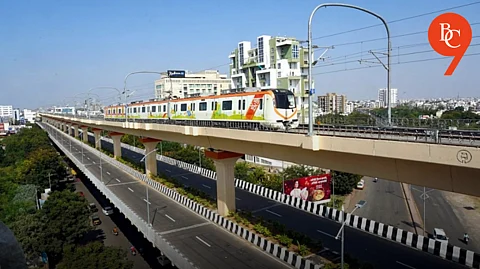

The double-decker flyover, a first of its kind at this scale in Pune, is being constructed to address chronic congestion on Ganeshkhind Road-a key arterial route connecting Hinjewadi, Shivajinagar, Baner, Aundh, and Pashan. The innovative two-tier design features:
Upper Deck: Dedicated to the Hinjawadi-Shivajinagar Metro line, supporting Pune’s expanding urban rail network.
Lower Deck: Reserved for vehicular traffic, providing uninterrupted movement and reducing bottlenecks at major junctions.
As of mid-May 2025, all 32 supporting pillars have been erected, and the installation of massive steel girders-each 55 meters long and 18-20 meters wide-is progressing rapidly. The majority of the main structure is complete, with only the Pashan-side ramps requiring additional work expected to extend into the coming months.
The flyover connects critical city points, including Ganeshkhind Road, Senapati Bapat Road, Baner, Aundh, and Pashan, and will streamline access between Hinjewadi and Shivajinagar. The upper deck will carry the metro, supporting Pune’s push for integrated, multi-modal transport solutions. Ramps leading to Aundh and Shivajinagar are nearly finished and expected to open by May 20, 2025. Utility shifting near the Baner ramp is also in its final phase, while the Pashan-side ramps will take a few more months to complete.
The flyover is designed to significantly ease daily traffic snarls that have long plagued Ganeshkhind Road and adjoining areas. Once operational, it is expected to:
Reduce Travel Time: By separating metro and road traffic, the flyover will minimize congestion and shorten commute times for thousands of daily travelers.
Enhance Safety: The new structure will help manage high traffic volumes more efficiently, reducing the risk of accidents at key intersections.
Support Urban Growth: Improved connectivity will benefit residents, businesses, and institutions in the rapidly developing western Pune corridor.
The project, originally slated for completion in May 2025, faced delays due to land acquisition, road widening, and utility shifting. Despite these setbacks, PMRDA has maintained steady progress, with major civil works now finished and the focus shifting to final touches and ramp completion.
Commuters have experienced increased disruptions during construction, leading to frustration and calls for authorities to expedite the remaining work. PMRDA officials remain confident that the main flyover will be operational by June 30, 2025, marking a significant relief for Pune’s traffic woes.
The Pune University Chowk double-decker flyover is part of a broader city strategy to deploy multi-level flyovers and integrated transport solutions across Pune. With similar projects planned at other key locations, the success of this flyover could serve as a blueprint for future urban infrastructure in the city.
